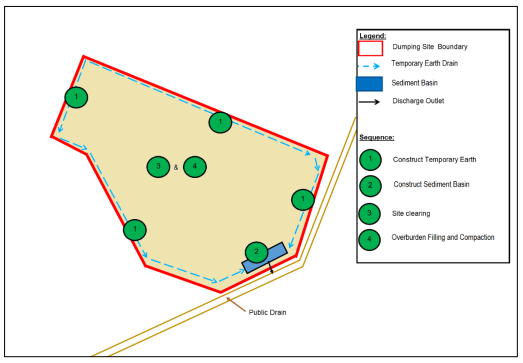HOME / ISOMETRIC MAP / SENSITIVE OR PROTECTED AREA / OPERATION / 5.0 MANAGEMENT AND DISPOSAL OF OVERBURDEN
5.0 MANAGEMENT AND DISPOSAL OF OVERBURDEN
Figure 10: Illustration of overburden dumping stages.
3. No direct discharge of surface runoff from the disturbed area into public drains, rivers, or watercourses.
4. No construction of runoff management and sediment control facilities in rivers or watercourses.
5. Conduct site clearing within the active working area only.
6. Conduct disposal activities by stages and avoid activities during rainy days.
7. Compact overburden materials at least twice per week to reduce soil erosion.
8. Locate overburden dumping site in an area more than 30 meters away from any riverbank or waterway.
9. Prohibit dumping of overburden outside the dumping site boundary.
10. No disposal of overburden into any river, waterway, or within the riparian buffer.
11. Erect suitable speed limit and safety signs at the dumping site entrance to notify public road users.
12. Construct a wash bay / wash through with a silt trap of not less than 1m x 1m x 1.2m (depth) in size (based on Drawing design) at the location shown in the approved EIA/PMM and AEC/MD.
13. Clean tyres and undercarriage of transportation vehicles at the wash bay / wash through before leaving the dumping site to avoid formation of bulky deposited dirt and earth on public road surfaces.
14. Refer to requirements from the Local Authorities for transportation routes and/or JKR for access involving road reserves (application of wayleave).
15. Obtain consent from private landowners if access through their land is required.
16. Cover transported overburden materials with canvas or tarpaulin sheets.
17. Avoid off-site transportation activities during peak traffic hours stated in the AEC/MD.

